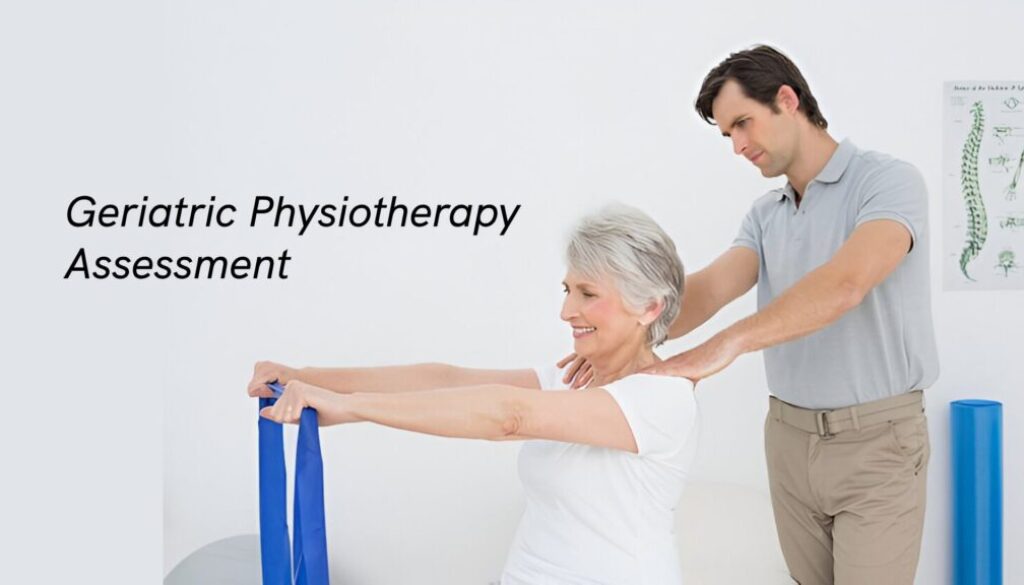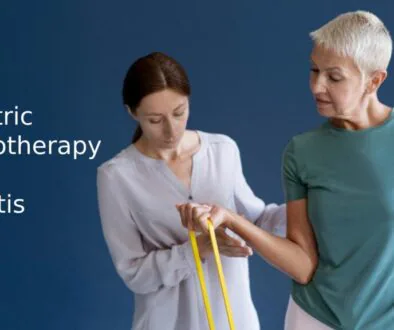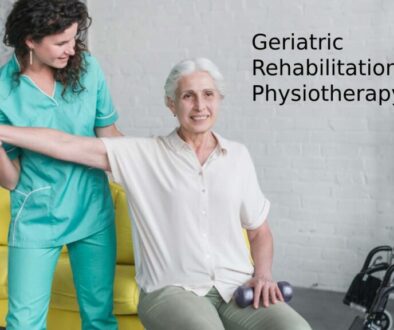Geriatric Physiotherapy Assessment: Guide to Senior Care
Introduction
Aging comes with its own set of challenges, especially when it comes to mobility and physical function. Geriatric physiotherapy plays a crucial role in maintaining independence, improving strength, and enhancing the overall quality of life for older adults. But before designing a treatment plan, a geriatric physiotherapy assessment is essential. This assessment helps identify mobility limitations, balance issues, and other physical challenges that could impact daily life.
The goal of geriatric physiotherapy assessment is to:
- Identify mobility impairments and functional limitations
- Detect fall risks and prevent injuries
- Improve physical strength, endurance, and flexibility
- Promote independence in activities of daily living (ADLs)
By understanding the unique needs of elderly patients, physiotherapists can tailor a rehabilitation program that enhances mobility, reduces pain, and improves overall well-being.
Understanding Geriatric Physiotherapy
What is Geriatric Physiotherapy?
Geriatric physiotherapy is a specialized branch of physiotherapy focusing on physically rehabilitating elderly individuals. It aims to address age-related conditions such as osteoporosis, arthritis, post-stroke complications, and reduced balance.
How It Differs from Regular Physiotherapy
Unlike traditional physiotherapy, which often focuses on recovery from injuries or surgeries, geriatric physiotherapy takes a holistic approach to maintain mobility, reduce pain, and improve the overall functional ability of seniors. It also considers cognitive decline, chronic illnesses, and frailty, which are common in older adults.
Key Components of Geriatric Physiotherapy Assessment
A proper assessment in geriatric physiotherapy involves multiple steps to ensure a clear understanding of the patient’s condition.
Medical History and Patient Interview
- Review of past medical conditions (stroke, osteoporosis, arthritis, etc.)
- Medications and their impact on mobility
- Previous injuries or surgeries
- Lifestyle habits (diet, exercise, social activity)
Physical Examination
- Assessing muscle strength, flexibility, and joint function
- Observing posture and body mechanics
- Identifying areas of pain and discomfort
Functional Mobility Assessment
- Evaluating walking patterns and balance
- Testing ability to stand, sit, and transition between movements
- Assessing fall risk using standardized tools
Common Geriatric Conditions Requiring Physiotherapy
Several conditions affect the mobility and physical function of elderly patients, necessitating physiotherapy intervention.
Osteoarthritis and Joint Pain
- Stiffness and pain in weight-bearing joints
- Reduced mobility and difficulty in performing ADLs
Stroke and Neurological Conditions
- Paralysis and muscle weakness
- Loss of balance and coordination
- Rehabilitation to regain functional movement
Parkinson’s Disease
- Tremors, stiffness, and slow movement
- Postural instability leading to fall risks
Frailty and Muscle Weakness
- Reduced muscle mass and strength
- Difficulty in performing daily tasks like walking or climbing stairs
Physical Assessment in Geriatric Physiotherapy
A physical assessment helps in evaluating the patient’s mobility, strength, and endurance levels.
Posture and Balance Evaluation
- Checking for spinal alignment issues
- Assessing core strength and stability
Range of Motion (ROM) Assessment
- Evaluating joint flexibility
- Identifying stiffness or pain in movement
Strength and Endurance Tests
- Testing upper and lower body strength
- Evaluating stamina during simple movements
Functional Mobility and Gait Assessment
Functional mobility is a key aspect of a geriatric physiotherapy assessment, as it helps determine the patient’s ability to move independently and safely. A gait assessment evaluates walking patterns, while a functional mobility assessment measures how well an elderly person can perform basic movements such as standing, walking, and sitting.
Gait Analysis Techniques
Gait analysis is essential in detecting abnormalities that can lead to falls or mobility issues. Physiotherapists use several methods, including:
- Observational Gait Analysis (OGA): The therapist visually examines the patient’s walking patterns, noting any asymmetries, abnormal movements, or compensations.
- Timed Up and Go (TUG) Test: The patient is asked to stand up from a chair, walk a short distance, turn around, and sit down again. A time of more than 12 seconds may indicate a high fall risk.
- Gait Speed Test: Measures walking speed over a specific distance, with slower speeds correlating with a higher risk of falls.
- Footprint Analysis: Used to assess step length, width, and symmetry by walking on a pressure-sensitive mat or using digital tools.
Assistive Device Evaluation
Many elderly individuals rely on assistive devices like canes, walkers, or orthotic supports to maintain balance and mobility. Physiotherapists assess:
- Whether the current device is suitable for the patient’s condition.
- Proper height adjustment and grip for safety and comfort.
- The patient’s ability to use the device correctly to avoid falls.
Risk of Falls Assessment
Falls are a major concern for the elderly, often leading to fractures and hospitalization. Physiotherapists conduct fall risk assessments using tools like:
- Berg Balance Scale (BBS): Measures functional balance through 14 tasks, such as standing on one leg and reaching forward.
- Functional Reach Test (FRT): Assesses stability by measuring how far a patient can reach forward without losing balance.
- One-Leg Stand Test: Determines balance by timing how long the patient can stand on one leg.
Pain and Sensory Assessment
Pain and sensory deficits can significantly affect an elderly person’s ability to move and perform daily activities. A thorough pain and sensory assessment helps physiotherapists tailor interventions to reduce discomfort and improve function.
Evaluating Pain Levels and Types
Pain in older adults can stem from arthritis, neuropathy, past injuries, or muscle stiffness. The Visual Analog Scale (VAS) and Numeric Rating Scale (NRS) are commonly used to measure pain intensity. Other pain characteristics assessed include:
- Location: Which joints or muscles are affected?
- Duration: Is the pain chronic or intermittent?
- Triggers: Does movement, weather, or prolonged sitting worsen the pain?
Sensory Testing for Neuropathy
Neuropathy, common in conditions like diabetes, affects sensation in the feet and hands. Physiotherapists use tests like:
- Monofilament Test: A fine nylon filament is pressed against the skin to check for sensitivity loss.
- Vibration Test (Tuning Fork): Evaluates the ability to feel vibrations, which can indicate nerve damage.
- Temperature Sensitivity Test: Determines if the patient can differentiate between hot and cold stimuli.
Impact of Pain on Mobility
Chronic pain can lead to reduced activity levels, muscle weakness, and fear of movement. Physiotherapists design pain management strategies such as:
- Gentle stretching exercises to improve flexibility.
- Heat and cold therapy for muscle relaxation and pain relief.
- Manual therapy techniques to release muscle tension.
Cognitive and Psychological Assessment
Cognitive function and mental health play a critical role in geriatric physiotherapy, as conditions like dementia, depression, and anxiety can impact movement, motivation, and therapy outcomes.
Screening for Dementia and Cognitive Decline
Dementia affects memory, problem-solving, and coordination, making physical therapy challenging. Physiotherapists use:
- Mini-Mental State Examination (MMSE): A simple 30-point test assessing orientation, recall, and problem-solving skills.
- Montreal Cognitive Assessment (MoCA): A more detailed test evaluating memory, attention, and executive function.
- Clock Drawing Test: A quick tool for assessing cognitive and visual-spatial abilities.
Depression and Anxiety Assessment
Depression and anxiety are common in older adults, often leading to low motivation, fatigue, and reduced physical activity. Screening tools include:
- Geriatric Depression Scale (GDS): A questionnaire assessing mood and emotional well-being.
- Patient Health Questionnaire (PHQ-9): Identifies symptoms of depression, such as loss of interest and energy.
- Generalized Anxiety Disorder (GAD-7) Scale: Measures anxiety levels and their impact on daily life.
Impact of Mental Health on Mobility
Mental health disorders can lead to:
- Reduced participation in therapy sessions.
- Fear of movement (kinesiophobia) due to pain or past falls.
- Increased muscle tension, leading to stiffness and discomfort.
Physiotherapists incorporate motivational strategies, cognitive exercises, and relaxation techniques to improve therapy outcomes in patients with cognitive or emotional challenges.
Cardiovascular and Respiratory Assessment
Cardiovascular and respiratory health directly impact an elderly patient’s exercise tolerance, endurance, and mobility.
Assessing Heart Rate and Blood Pressure
Elderly patients often have hypertension, heart disease, or irregular heartbeats, which can limit their ability to exercise. Physiotherapists monitor:
- Resting heart rate (RHR) to detect abnormalities.
- Blood pressure (BP) before and after activity to assess cardiovascular response.
- Oxygen saturation (SpO2) using a pulse oximeter to ensure adequate oxygen levels.
Respiratory Function and Endurance
Conditions like chronic obstructive pulmonary disease (COPD) and asthma can reduce an elderly person’s ability to exercise. Assessment includes:
- Breathlessness Scale (Modified Borg Scale): Measures the severity of breathlessness during activity.
- Peak Expiratory Flow (PEF) Test: Evaluates lung function in patients with respiratory conditions.
- 6-Minute Walk Test (6MWT): Assesses endurance by measuring how far the patient can walk in six minutes.
Role of Physiotherapy in Cardiac Rehabilitation
Physiotherapists help elderly patients improve cardiovascular fitness and lung capacity through:
- Aerobic exercises (e.g., walking, cycling) at a safe intensity.
- Breathing exercises to improve oxygen flow and endurance.
- Gradual strengthening programs to rebuild stamina post-cardiac events.
Balance and Fall Risk Assessment
Falls are one of the leading causes of injury and disability in older adults. A thorough balance assessment helps prevent falls and improve safety.
Tools for Fall Risk Assessment
- Berg Balance Scale (BBS): Assesses static and dynamic balance through functional tasks.
- Tinetti Performance-Oriented Mobility Assessment (POMA): Evaluates balance and gait through a series of movements.
- Functional Reach Test (FRT): Measures stability and ability to recover from minor balance disturbances.
Strategies for Fall Prevention
- Strength training for legs and core muscles.
- Balance exercises (e.g., standing on one leg, tandem walking).
- Home modifications (e.g., removing trip hazards, installing handrails).
Home Safety Recommendations
Physiotherapists educate patients and caregivers on:
- Proper lighting in hallways and bathrooms.
- Using non-slip mats in bathrooms and kitchens.
- Wearing supportive footwear instead of loose slippers.
Activities of Daily Living (ADL) Assessment
The ability to perform Activities of Daily Living (ADLs) is a critical factor in determining an elderly person’s level of independence. Physiotherapists assess ADLs to develop rehabilitation plans that enhance self-sufficiency.
Evaluating Independence in Daily Activities
ADLs are divided into two categories:
- Basic Activities of Daily Living (BADLs)
- Bathing
- Dressing
- Eating
- Using the toilet
- Transferring (e.g., from bed to chair)
- Instrumental Activities of Daily Living (IADLs)
- Cooking
- Managing medications
- Handling finances
- Doing housework
- Using transportation
Several standardized tools, such as the Barthel Index and Katz Index of Independence in ADLs, help measure the level of assistance a patient requires.
Adaptive Strategies for Elderly Patients
For seniors struggling with ADLs, physiotherapists recommend:
- Adaptive equipment (e.g., grab bars, walkers, dressing aids).
- Energy conservation techniques to reduce fatigue.
- Task modification (e.g., sitting while dressing or using a long-handled sponge for bathing).
Role of Caregivers in Rehabilitation
Caregivers play an essential role in helping seniors regain function. Physiotherapists:
- Educate caregivers on safe transfer techniques to prevent injuries.
- Teach mobility exercises caregivers can assist with at home.
- Encourage fall prevention strategies in daily routines.
Nutritional and Lifestyle Considerations
Nutrition and lifestyle significantly impact mobility and rehabilitation success in older adults. A physiotherapy assessment includes an evaluation of dietary habits, hydration levels, and lifestyle factors.
The Impact of Nutrition on Physical Therapy
Proper nutrition supports muscle function, energy levels, and recovery. Physiotherapists work with dietitians to ensure:
- Adequate protein intake for muscle strength.
- Sufficient calcium and vitamin D to maintain bone health.
- Balanced hydration to prevent fatigue and dizziness.
Hydration and Muscle Function
Dehydration can cause:
- Muscle cramps
- Dizziness
- Increased risk of falls
Physiotherapists encourage elderly patients to drink enough water daily and monitor signs of dehydration.
Lifestyle Modifications for Better Mobility
To enhance mobility, elderly individuals should:
- Engage in regular low-impact exercises like walking and swimming.
- Get adequate sleep to support muscle recovery.
- Avoid excessive alcohol and smoking, which affect bone density and circulation.
Developing a Personalized Physiotherapy Plan
A personalized physiotherapy plan is based on the assessment findings and tailored to the individual’s needs and goals.
Setting Short-Term and Long-Term Goals
- Short-term goals: Improving balance, reducing pain, and increasing joint mobility.
- Long-term goals: Enhancing independence in ADLs, increasing endurance, and preventing falls.
Designing an Individualized Exercise Regimen
Physiotherapists create customized programs that include:
- Strength training (e.g., resistance bands, bodyweight exercises).
- Flexibility exercises (e.g., gentle stretching).
- Aerobic exercises (e.g., walking, cycling).
- Balance exercises (e.g., single-leg stance, Tai Chi).
Monitoring Progress and Reassessment
Regular reassessments track improvement and make necessary adjustments. Techniques include:
- Re-evaluating mobility tests (e.g., TUG test, Berg Balance Scale).
- Tracking pain levels and modifying interventions accordingly.
- Assessing ADLs to ensure continued independence.
Challenges in Geriatric Physiotherapy Assessment
Physiotherapists often encounter challenges when assessing elderly patients, including communication barriers, multiple medical conditions, and adherence to treatment plans.
Communication Barriers
Hearing loss, cognitive decline, or language differences can make assessment difficult. Solutions include:
- Speaking slowly and clearly.
- Using visual aids or demonstrations.
- Encouraging family involvement in discussions.
Comorbidities and Medical Complexities
Elderly individuals often have multiple health issues, such as:
- Diabetes, which affects healing and sensation.
- Heart disease, which limits endurance.
- Arthritis, which causes chronic pain and stiffness.
A holistic approach is needed to balance treatment for various conditions while ensuring patient safety.
Adherence to Treatment Plans
Many elderly patients struggle with following exercise programs due to:
- Forgetfulness (especially in cognitive impairment cases).
- Fear of pain or injury.
- Lack of motivation.
Physiotherapists encourage adherence by:
- Simplifying exercises and making them enjoyable.
- Providing written instructions or videos for home exercises.
- Involving caregivers to ensure consistency.
Conclusion
A geriatric physiotherapy assessment is a vital step in improving mobility, preventing falls, and enhancing the quality of life for elderly individuals. By evaluating physical, cognitive, and functional abilities, physiotherapists can create personalized rehabilitation programs that restore independence and promote long-term health.
Encouraging early assessment and intervention ensures better outcomes, allowing seniors to maintain their dignity and live life with confidence. With the right care, support, and commitment to therapy, older adults can enjoy active, pain-free, and independent lives.
Frequently Asked Questions (FAQs)
What is the purpose of a geriatric physiotherapy assessment?
A geriatric physiotherapy assessment identifies mobility limitations, balance issues, and functional impairments to design a customized rehabilitation program that improves independence and reduces fall risks.
How do physiotherapists assess fall risk in elderly patients?
Physiotherapists use gait analysis, balance tests (e.g., Berg Balance Scale), and functional mobility tests (e.g., Timed Up and Go Test) to determine fall risk and recommend preventive strategies.
What role does nutrition play in geriatric physiotherapy?
Good nutrition supports muscle strength, bone health, and energy levels, which are essential for effective physiotherapy outcomes. Protein, calcium, and hydration play crucial roles in recovery and mobility.
Can physiotherapy help with dementia-related mobility issues?
Yes, physiotherapy can improve coordination, balance, and strength in dementia patients, reducing their risk of falls and promoting better movement. Sessions may also include cognitive-motor exercises to enhance brain function.
What exercises are best for elderly patients with limited mobility?
Gentle exercises such as chair yoga, resistance band workouts, water therapy, and seated leg lifts help maintain strength and flexibility while reducing the risk of injury.


